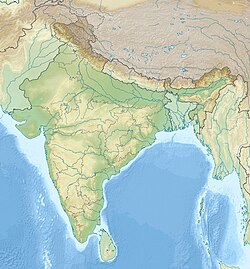
Back Souvrství Lameta Czech Formation de Lameta French Formasi Lameta ID ലമേറ്റാ ശിലാക്രമം Malayalam Formacion Lameta Occitan
| Lameta Formation | |
|---|---|
| Stratigraphic range: Maastrichtian ~ | |
 Exposure of the Lameta Formation at its type locality of Lameta | |
| Type | Geological formation |
| Underlies | Intertrappean Beds, Deccan Traps deposits |
| Overlies | Jabalpur Group or Precambrian Basement |
| Area | 5,000 km2 (1,900 sq mi) |
| Thickness | Variable, typically 18–45 m (59–148 ft) |
| Lithology | |
| Primary | Claystone, sandstone limestone |
| Other | Conglomerate |
| Location | |
| Coordinates | 23°12′N 80°00′E / 23.2°N 80.0°E |
| Approximate paleocoordinates | 24°42′S 63°12′E / 24.7°S 63.2°E |
| Region | Western India |
| Country | |
| Extent | Madhya Pradesh, Gujarat, Maharashtra, Andhra Pradesh, Telangana |
| Type section | |
| Named for | Lameta Ghat |
The Lameta Formation, also known as the Infratrappean Beds (not to be confused with the contemporaneous Intertrappean Beds), is a sedimentary geological formation found in Madhya Pradesh, Gujarat, Maharashtra, Telangana, and Andhra Pradesh, India, associated with the Deccan Traps.[1] It is of the Maastrichtian age (Late Cretaceous), and is notable for its dinosaur fossils.
- ^ Wilson Mantilla, Gregory P.; Renne, Paul R.; Samant, Bandana; Mohabey, Dhananjay M.; Dhobale, Anup; Tholt, Andrew J.; Tobin, Thomas S.; Widdowson, Mike; Anantharaman, S.; Dassarma, Dilip Chandra; Wilson Mantilla, Jeffrey A. (2022-04-01). "New mammals from the Naskal intertrappean site and the age of India's earliest eutherians". Palaeogeography, Palaeoclimatology, Palaeoecology. 591: 110857. Bibcode:2022PPP...59110857W. doi:10.1016/j.palaeo.2022.110857. ISSN 0031-0182.
